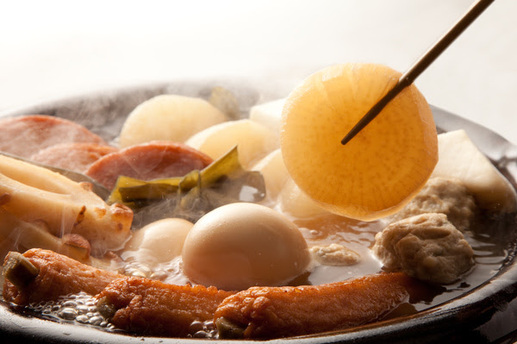2025.01.23
伝検通信(メルマガ)週刊メールマガジン「伝検通信」 第42号
週刊メールマガジン「伝検通信」第42号をお届けします。
今週のトップ記事は、白洲信哉さん「多様なるジャパン」の連載第3回、「茶の美」を雄弁に物語る茶道具の話題です。
「クイズで肩慣らし」は、前回クイズの答え・解説と、陶磁器に関する問題です。今月末までの第1回検定期間中は同試験の出題対象から外し、伝統文化に関するさまざまな問題をお届けします。
現在実施中の2級および3級の第1回伝検は下記サイトから申込みできます。ぜひトライしてみてください。公式テキスト、2級受験者向けオンライン講座も販売しています。
伝検申込サイト https://denken-test.jp/
目次
・ 「多様なるジャパン」 第3回 唐物と高麗茶碗
・ 「クイズで肩慣らし」第41回=「陶磁器」
・ 伝検協会だより
「多様なるジャパン」 第3回 唐物と高麗茶碗
白洲信哉=文筆家、日本伝統文化検定協会副会長

国宝「油滴天目茶碗」
大阪市立東洋陶磁美術館(住友グループ寄贈/安宅コレクション) 写真:西川茂
茶の湯はわが国伝統文化の柱である。喫茶の習慣は中国で始まり、12世紀末、栄西が臨済禅とともにその功徳を説いて後の茶の湯の端緒となる。室町時代に入ると抹茶法の広がりとともに、書院造りの中で唐物を賞翫(しょうがん)する際の添えものとして、台天目を使い給されるようになる。15世紀末東山文化のシンボル銀閣を造営した義政の代に村田珠光が「侘茶」を唱え、名物鑑賞から独立し喫茶をメインとした茶の湯が百年後千利休により大成、以後およそ400年、時代の潮流に合わせさまざまな美意識が取り込まれ洗練されていく。
僕は茶の手前などまるで不案内なので茶の湯について語る資格はないが、「茶の美」を雄弁に物語るのが茶道具だと思う。鎌倉時代多量に輸入された天目や茶入に茶壺など黒釉の、一見地味で魅力の乏しい日常の消耗品から「美」を選別し、中国では無関心の例えば無文様の胡銅(こどう)を高く評価するなど日本美として拾い上げていく。中でも黒釉茶碗の偶然美しい結晶が生れたかの曜変天目(ようへんてんもく)茶碗は世界に三碗、本場に完品はなく日本に輸入され国宝に指定されている。同じように井戸茶碗に代表される朝鮮時代の平凡な器にも惚れ込み、日本では傑作としてこれまた国宝になった名物もある。完成度の高い唐物と肌の異なる高麗茶碗に楽茶碗を始めとする日本製など全く雰囲気の異なるモノが同居していく。
一般に「侘び寂び」と簡易に表現しているが、道長の「我が世とぞおもふ望月」から珠光の「月も雲間のなきは嫌」と完璧から不完全なモノへ美意識が変化、当初の台子茶(だいすちゃ)から四畳半そして「待庵(たいあん)」の二畳台目まで引き算を重ね洗練される中、豪華絢爛な聚楽第(じゅらくだい)の書院と異質な薄暗い極小空間が並走していく。根底には平家滅亡に始まる「もののあはれ」に珠光の師事した一休らの禅的な価値観や同時代に生きた世阿弥の「凍み氷りて静かに美しく出で来たる能」に連歌師心敬など新たな美的体験者の「美の創造」から、今に繋がるわが国の心持ち「本物の感動とは何か」という探求意欲から躙口(にじりぐち)他創意工夫が行われた。
茶の湯道具の取り合わせに釣り合いが重要視されているのは、独裁的運営よりコンセンサス重視の会社経営や、某党の主流反主流といった派閥均衡型の人事にもどこか似ている。道具選び次第で多様な演出「見立て」は可能だが、目が利かないと見所ない無為な時間になる。「見立て」とは美意識全般において通じるだけでなく、人生の自由度も無限で多様であると「和漢の境」を生き抜いた伝世の道具たちは語っているのである。
「クイズで肩慣らし」第41回=「陶磁器」
~第1回検定期間中のクイズは同試験の出題対象から外します。またテキストの分野以外からも取り上げます~

遺跡もりあげ隊キャラクター「むーもん」(イラスト)
第41回
問題:日本で世界最古級ともいわれる土器が発掘された遺跡の名称は、何でしょう。(答えと解説は次号で)

寒い季節においしいおでん
【前回の問題と答え・解説】
問題:冬の定番料理、おでんの季節です。その語源となり、能楽の成り立ちにも影響を与えたといわれる民俗芸能は何でしょう。
答え:田楽(でんがく)
解説:田楽は平安時代から主に農村地帯で発展した芸能で、五穀豊穣(ごこくほうじょう)を祈って演じる役者は田楽法師と称されました。かさをかぶったいでたちとその舞い姿に見立て、豆腐やこんにゃく、里芋を串に刺した焼き物も田楽と呼ばれるようになりました。その後に丁寧語の接頭辞「お」が付き、略して「おでん」になったといわれていますが、農林水産省によると、現在のような煮込み料理に進化したのは近代以降のことのようです。室町時代に能楽を大成した観阿弥、 世阿弥親子が田楽の影響を受けたとも伝えられています。
伝検協会だより
▼現在実施している第1回伝検(2級・3級)
【伝検】検定合格者へのプレゼント=京染合格認定証ケースができ
なお、第2回検定は6月1日から実施します。申し込みは5月1日開始です。
https://denken-test.jp/examination/
編集後記
伝検通信第42号をお届けしました。伝検はCBT(コンピューターを用いた試験)で、その場で合否が分かります。駆け込み受験、大歓迎です。ぜひこの機会に受験してみてください。
【English version】
Weekly e-newsletter Denken Tsushin, No. 42.
We are pleased to present the 42nd issue of our weekly e-newsletter, Denken Tsushin.
This week's top article is the third in the series by Shinya Shirasu, ‘Diverse Japan’, on the topic of tea utensils, which eloquently illustrate the ‘beauty of tea’.
In the ‘Let's Practice with Quizzes’ section, you'll find answers and explanations to the previous quiz, as well as questions on ceramics. During the first examination period, which ends at the end of this month, we will be taking the subject out of the same examination and bringing you a variety of questions on traditional culture.
You can apply for the first Dengen examinations for Level 2 and Level 3, which are currently being conducted, at the website below. Please try it out. Official textbooks and online courses for Level 2 candidates are also available.
Denken application website: https://denken-test.jp/examination/
Contents.
・Diverse Japan - Vol. 3 Karamono and Koryo Tea Bowls
・‘Let's Practice with Quizzes’ No. 41: Ceramics
・From the Denken Kyokai
Diverse Japan - No. 3 Karamono and Korai Tea Bowls
Shinya Shirasu = writer, vice-president of the Japan Traditional Culture Testing Association

National Treasure, Oil Drop Tenmoku Tea Bowl.
The Museum of Oriental Ceramics, Osaka (Gift of Sumitomo Group / Ataka Collection) Photo: Shigeru Nishikawa.
Chanoyu is a pillar of traditional Japanese culture. The custom of tea drinking originated in China, and at the end of the 12th century, Eisai, together with Rinzai Zen, taught the merits of the tea ceremony, which became the beginning of later chanoyu. In the Muromachi period (1336-1573), with the spread of the powdered green tea method, the use of dai-tenmoku (a type of tea utensil) as an accompaniment to the appreciation of karamono in shoin-style buildings began, and at the end of the 15th century, Murata Shuko, who built the Ginkaku, a symbol of Higashiyama culture, advocated wabicha, or tea ceremony independent of the appreciation of specialities, and tea ceremony with tea as the main activity, was developed over a hundred years. The tea ceremony was developed by Sen no Rikyu, and in the 400 years since then, various aesthetics have been incorporated and refined in accordance with the trends of the times.
I am not qualified to talk about the tea ceremony, as I am not familiar with the tea ceremony itself, but I think that tea utensils speak eloquently of the beauty of tea. The beauty of black-glazed daily consumables such as tenmoku, tea caddies and tea pots imported in large quantities during the Kamakura period (1185-1333), which at first glance appear plain and unattractive, is selected and appreciated as Japanese beauty, such as the high regard given in China to the unattractive, patternless hutong (kodou). Among these, the Yohhen Temmoku tea bowl, which is a beautiful crystallisation of accidental black-glazed tea bowls, is one of only three in the world that has been imported to Japan and designated as a national treasure. In the same way, there is also a masterpiece that fell in love with an ordinary bowl from the Joseon period, represented by the well tea bowl, and became a masterpiece in Japan, also a national treasure. The Chinese tea bowls with a high degree of perfection and Koryo tea bowls with a different skin, as well as Japanese-made objects such as Raku tea bowls, all with completely different atmospheres, cohabitate with each other.
The aesthetic sense changed from perfection to imperfection, from Michinaga's ‘My world and the moon’ to Shuko's ‘I don't want the moon to be between the clouds’, and from the original daizucha to the four-and-a-half tatami mats and the two tatami mats of the ‘taian’. (The luxurious and gorgeous Shoin of the Juraku-dai (聚楽第) and the alien, dimly lit, tiny space run side by side. The foundation of the work is based on the Zen values of Ikkyu and others who studied under Shuko's master, and on Zeami's ‘frozen Noh that comes out quietly and beautifully’ and the ‘creation of beauty’ of new aesthetic experiencers such as the renga master Shinkei, who lived in the same era. The tea ceremony was a time of ingenuity and ingenuity.
The importance placed on balance in the selection of utensils for the tea ceremony is somewhat similar to that of company management, which emphasises consensus rather than autocratic management, or to the personnel balance between the mainstream and anti-mainstream factions of a certain political party. A wide variety of ‘sight-seeing’ is possible, depending on the choice of equipment, but if you are not discerning, it can be a pointless waste of time. The tools of the past, which have survived the ‘borderland of the Japanese and Chinese’, tell us that ‘kiken’ not only applies to aesthetics in general, but also to the unlimited and varied freedom of life.
‘Let's Practice with Quizzes’ No. 41 = ‘Ceramics’
~The quiz during the first examination period is excluded from the same examination. It will also cover subjects outside the field of the text -.

Mumon, the character of the site enhancement team (illustration).
41st.
Question: what is the name of the site where pottery, said to be among the oldest in the world, was excavated in Japan? (Answers and explanations will appear in the next issue.)

Delicious oden in cold weather
Previous Question & Answer/Explanation.
Question: It is the season for oden, a classic winter dish. What folk art is said to have been the origin of the word and to have influenced the origins of Noh theatre?
Answer: Dengaku.
Explanation: Dengaku is a performing art that developed mainly in rural areas from the Heian period (794-1185), and the actors who performed it to pray for a good harvest were called dengaku-houshi. Dengaku also came to be called grilled tofu, konnyaku and taro skewered to resemble the actors and their dancing figures, who wore umbrellas. Later, the polite prefix ‘o’ was added and it is said to have been abbreviated to ‘oden’, but according to the Ministry of Agriculture, Forestry and Fisheries, it was only after the modern era that it evolved into the stewed dish it is today. According to the Ministry of Agriculture, Forestry and Fisheries, it is said that Kan'ami and Zeami, who developed Noh theatre in the Muromachi period (1336-1573), were influenced by dengaku.
From the DENKEN Association
The deadline for applications for the 1st DENKEN (Levels 2 and 3) examinations currently being conducted is approaching on Tuesday 28 January. If you have not yet applied, please do so before the deadline. The examination period ends on Friday 31 January. Successful applicants for the first examination will receive a card-shaped certificate made of Japanese paper and a Kyoto-dyed certificate case. The case was produced with the cooperation of Hineno Katsujiro Shoten (https://www.katsujirou.com), a long-established company in the Kyoto-dyeing Sikkaichi business, and is a unique item that only those who have passed the exam can have, as the DENKEN logo is beautifully coloured by the craftsmen's reliable skills. Click here to see how it was made.
The process of making the Kyozome Certificate Case, a present for those who have passed the DENKEN Certificate Examination.
The second test will be held from 1 June. Applications will be accepted from 1 May.
https://denken-test.jp/examination/
Editor's Postscript
Denken News Letter No. 42 is now available. The DENKEN is a CBT (computer-based test), and you will know whether you have passed or failed on the spot. You are welcome to take the test at short notice. Please take this opportunity to take the test.
カテゴリー: 伝検通信(メルマガ)





